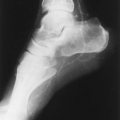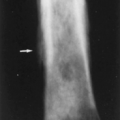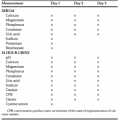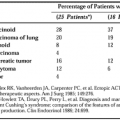GENETIC MUTATIONS IN THYROID HORMONE RESISTANCE SYNDROMES
Generalized resistance to thyroid hormone is a genetic disease. Most reported cases belong to families with multiple affected members, and inspection of these pedigrees reveals that, in all but the original Refetoff kindred, the abnormal trait is transmitted dominantly.2 Compelling evidence that generalized resistance to thyroid hormone is a disease of the c-erbAβ thyroid-hormone receptor gene has come from linkage studies.2,5,6 Restriction fragment length polymorphisms (RFLPs) have been used to establish tight linkage between the β receptor gene and the syndrome of generalized resistance to thyroid hormone. Given the dominant inheritance pattern of pedigrees of generalized resistance to thyroid hormone, it was originally postulated that resistance occurred because mutant β receptors inhibited the activity of the normal β and α1 receptors (from one and two alleles, respectively).6 This hypothesis was convincingly proved in humans from the recessive kindred that has been extensively studied by Refetoff and coworkers.7,8 Sixty-five different mutations in the c-erbAβ gene have been identified in 115 families with either generalized or selective pituitary resistance to thyroid hormone9 (Fig. 32-2). These mutations exist as single (i.e., heterozygous) alleles, except in the Refetoff and Bercu patients.7,8,10,11 The majority of the c-erbAβ mutations is located in the penultimate and final exons of the gene and reduce T3-binding affinity; these mutations cluster within two hot spots in the T3-binding domain between amino acids 310-353 and 429-461.2,9
Presently, only one exception exists to the c-erbAβ rule. A kindred has been reported in whom the resistance phenotype is not linked to the c-erbAβ gene and who has no c-erbAβ1 or c-erbAβ2 defect.12 These data suggest that other factors that mediate thyroid hormone action may be defective, resulting in thyroid hormone resistance.
HOMOZYGOUS C-ERBAβ MUTATIONS IN REFETOFF AND BERCU PATIENTS
Two humans with mutations, the Refetoff and Bercu patients, provide important information on the interrelationships of the α and β receptors in mediating thyroid hormone action in humans (Fig. 32-3). These patients with mutations are homozygous for very different abnormalities in c-erbAβ and have very different phenotypes.
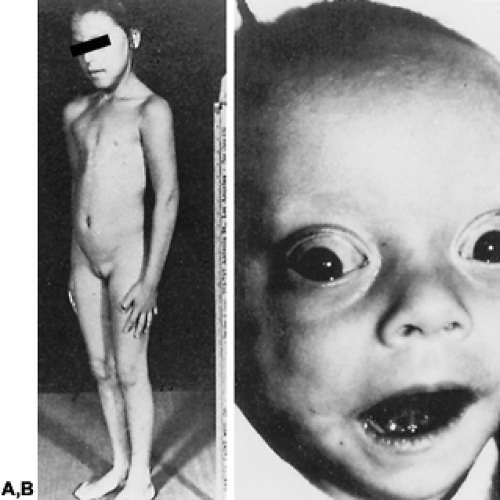 FIGURE 32-3. The Refetoff patient at 8.5 years of age (A) and the Bercu patient at 3.5 weeks of age (B). The Refetoff patient has a complete absence of functional β receptors. A bird-like facies and a pigeon chest are present. The Bercu patient is homozygous for a dominant negative β receptor (i.e., S receptor). Note the exophthalmos. (From Refetoff S, DeWind LD, DeGroot LJ. Familial syndrome combining deaf-mutism, stippled epiphyses, goiter, and abnormally high PBI: possible target organ refractoriness to thyroid hormone. J Clin Endocrinol Metab 1967; 27:279; and from Ono S, Schwartz ID, Mueller OT, et al. Homozygosity for a dominant negative thyroid hormone receptor gene responsible for generalized thyroid hormone resistance. J Clin Endocrinol Metab 1991; 73:990.)
Stay updated, free articles. Join our Telegram channel
Full access? Get Clinical Tree
 Get Clinical Tree app for offline access
Get Clinical Tree app for offline access

|


